by Amineddoleh & Associates LLC | Nov 20, 2020 |

Golden Coffin of Nedjemankh– looted from Egypt and sold with false provenance
The Victoria & Albert Museum in London is currently closed, but it continues to create and distribute valuable content examining issues related to art and heritage looting. Through Culture in Crisis, a program bringing together individuals and organizations with a shared interest in protecting cultural heritage, the museum is actively engaging with heritage professionals to provide insights into the dangers facing our shared history. One tool for raising awareness of these issues is the Culture in Crisis Podcast.
Season Two, Fighting the Illicit Trade, is comprised of interviews with international experts working to prevent the illegal trade of cultural heritage– each person fighting a battle to rescue cultural heritage at a different stage of its underground journey. The series examines the actions taken at the object’s source, through transit, and upon arrival at its destination. As stated by Culture in Crisis, “The theft and sale of cultural property robs communities of their past, present and future. It lines the pockets of international criminal networks and has been shown to directly finance terrorism. Through this series we hope to highlight valuable initiatives working to prevent the illicit trade and gather recommendations on how to build on these efforts in the future.”
Our founder, Leila A. Amineddoleh, is interviewed in Episode 7, “You’ve Gotta Have (Good) Faith.” She offers a legal perspective about heritage looting, discussing legal cases, provenance (including false provenances), good faith purchases, and the due diligence involved in purchasing antiquities. Read more about the series and listen to the informative interviews here.
by Amineddoleh & Associates LLC | May 1, 2020 |
Our founder had the opportunity to speak with Sarah Cascone of Artnet about the sale of looted antiquities on social media sites. As the coronavirus pandemic continues, historical and archaeological sites are more vulnerable than ever to theft and damage. This type of vulnerability was previously witnessed during the Arab Spring and the rise of ISIS. Now, a new wave of antiquities looting has spread across the Middle East, Africa – and Facebook. As individuals in heritage-rich countries face diminished income and economic opportunities, they turn to theft, and the internet has provided countless willing buyers for looted antiquities. Facebook is a popular means for looters to display their wares and carry out sales. The Antiquities Trafficking and Heritage Anthropology Research Project is tracking and monitoring stolen artifacts in the digital underworld and notes that there has been a significant increase in these cases, including the looting of a historic mosque in Morocco last week, with images shared on relevant Facebook groups. These groups even share tips on how to proceed with excavations without getting caught. As with more traditional channels, it is illegal to sell looted antiquities through internet sites. However, criminals use loopholes to create private groups where they can sell the items quickly and before police get involved. By the time law enforcement is alerted, the objects may have already disappeared deeper into the black market, as noted by Leila. When there are financial gains with relatively little risk, looters and middlemen pursue illegal sales, and they will continue to proliferate and exploit the situation unless stronger standards of protection are put in place. With limited resources, it is difficult for law enforcement agencies to monitor the global black market. Enacting firm policies prohibiting black market items, including antiquities, from being sold on the platform would help stem the tide of looting. Facebook could potentially employ a task force or a specialized compliance team to prevent the sale of illicit goods.
While some purchasers may turn a blind eye towards the provenance of these objects, some may genuinely be unaware that their purchased goods were stolen. Red flags in these types of transactions include depressed prices, unusual sources, origination in a conflict zone, and no verifiable provenance. For collectors to ensure that they have purchased legitimate works, they should carry out due diligence and request accompanying evidence as to the object of the sale, such as documentation pertaining to legal export and permission to sell from the country of origin, customs forms, verifiable information, prior publications, and research the sellers. Collectors should also contact knowledgeable legal counsel who can assist with transactions and ensure that everything is above board. Amineddoleh & Associates is experienced in a variety of cultural heritage transactions and our founder Leila Amineddoleh has been used by the Manhattan District Attorney’s Office as a legal expert for cases involving Mediterranean and Middle Eastern antiquities. Our firm has a successful track record in helping collectors perform due diligence and establish provenance, giving them piece of mind and allowing them to enjoy their purchases for years to come.
by Amineddoleh & Associates LLC | Jun 3, 2018 |
Note: All of the information in this blog post is taken from a publicly filed document. No confidential or privileged information was used in preparing this post.
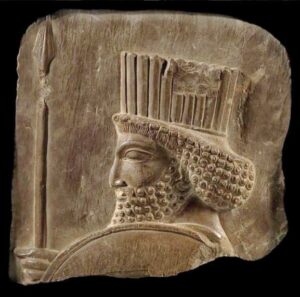 Last month, Assistant District Attorney Matthew Bogdanos petitioned the NY Supreme Court to turn over an Achaemenid limestone bas-relief that had been looted from Iran. Referred to as a “Persian Guard Relief,” the rare object was stolen from Persepolis in 1935. Our founder, Leila A. Amineddoleh, was instrumental in the filing of this case.
Last month, Assistant District Attorney Matthew Bogdanos petitioned the NY Supreme Court to turn over an Achaemenid limestone bas-relief that had been looted from Iran. Referred to as a “Persian Guard Relief,” the rare object was stolen from Persepolis in 1935. Our founder, Leila A. Amineddoleh, was instrumental in the filing of this case.
Persepolis, in current day Iran, is one of the world’s most treasured historical sites, with its name derived from Greek, meaning “Persian city.” Persepolis is considered by UNESCO to have “outstanding universal value.” UNESCO describes Persepolis as “magnificent ruins…among the world’s greatest archaeological sites… among the archaeological sites which have no equivalent and which bear unique witness to a most ancient civilization.” In 1931 excavations were begun at the site, and UNESCO declared the ruins a World Heritage Site in 1979.

Persepolis
© BornaMir/iStock.com
The ancient city, dating back to at least 515 B.C., was the capital of the Achaemenid Empire. Persepolis was built in terraces up from the river Pulwar to rise on a larger terrace of over 125,000 square feet, partly cut from a mountain. Darius I began construction of the site, and it developed until the Greeks plundered and razed the city under the leadership of Alexander the Great in 333 BC (purportedly in retribution for the destruction of the Parthenon by the Persians in 480 BC). The city was widely known as spectacular and breath-taking. As part of the site, Darius I built a palace known as the “Apadana,” used for official audiences. The looted relief at issue was stolen from this great hall.
The looted limestone bas-relief was stolen from Persepolis in 1935, during official excavations completed by the Oriental Institute at the University of Chicago. Authorities were alerted to the theft, and the Iranian government attempted to find and recover the piece, but it disappeared and entered the global black market, eventually making its way into a Canadian museum. Decades later, it was stolen from the museum, recovered, and then appeared at TEFAF in New York in the fall of 2017. At that point, the work was seized by the NY District Attorney’s Office after they learned of the work’s illicit origins. Our founder, Leila Amineddoleh, had informed authorities about the piece after learning about its plundered past by Dr. Lindsey Allen, Lecturer in Greek & Near Eastern History at King’s College in London. As the result of several years examining fragmentary reliefs from the site in museums around the world, and searching archives for their histories, Dr. Allen suspected the relief was looted. When Wace exported the relief for TEFAF, Dr. Allen contacted Ms. Amineddoleh, and explained why she thought the work was stolen.
Iran safeguards Persepolis due to its historic significance. In fact, Iran protects all of its cultural heritage, with the nation’s first patrimony laws passing in 1930. Because of these laws, there is no way that the relief left Iran legally, absent permission from the cultural ministry. Ms. Amineddoleh served as an expert to the District Attorney’s Office in advising on the relevant cultural heritage laws.
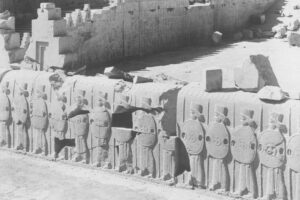
The eastern stairs at the Apadana in 1933.
(Photo: The Oriental Institute of University of Chicago, Photo 23188/ Neg.Nr. 12822
https://oi-idb.uchicago.edu/id/bec348b2-7e3c-49fd-8fd6-e9f057c92c4e)
The District Attorney’s Office submitted its turnover request on May 24 (read the document HERE: 18-05-24 PGR Motion for Turnover-reduced), but the case may carry on for some time. The limestone relief, part of an historical complex, has significance not only to the people of Iran, but to archaeologists and classicists, and to anyone visiting Iran’s most celebrated archaeological site. The limestone relief’s theft from Persepolis was tragic and damaging to the site, and hopefully the limestone guard will return to his home protecting the ancient site. The guards are designed to work in the site as a collective, not as individuals. Their fragmentation removes their context, and high-profile sales make other Achaemenid ruins potentially vulnerable to plunder.
by Amineddoleh & Associates LLC | May 3, 2018 |
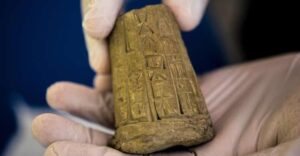
Photo courtesy of U.S. Immigration and Customs Enforcement (ICE)
Our founder, Leila A. Amineddoleh, served as a cultural heritage law expert for the Eastern District of New York in its case against Hobby Lobby. The national retail chain, Hobby Lobby, purchased over 5,500 ancient artifacts from dealers in the Middle East, after one of the world’s legal heritage experts, Patty Gerstenblith, warned the company about acquiring objects lacking clear provenance. She warned the company that classes of objects from Iraq (including cuneiform tables) have a high probability of being looted from archaeological sites. Ignoring the advice, the company moved forward with the purchases anyway, and the plundered artifacts (bearing shipping labels with falsified information) entered the US illegally.
Yesterday, nearly 4,000 of the pieces were returned to Iraqi officials at the embassy. These objects will most likely be displayed at Iraq’s National Museum.
Our firm is honored to have played a role in such a momentous repatriation. For more information about the case, please read one of our prior blog posts.
by Amineddoleh & Associates LLC | May 26, 2017 |
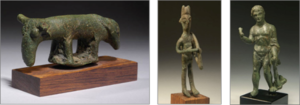
Yesterday Amineddoleh & Associates LLC had the honor of attending the repatriation ceremony for a collection of ancient artifacts returned to the Italian Republic. Manhattan District Attorney Cyrus R. Vance, Jr. recognized the importance of returning antiquities and honoring their repatriation with a ceremony and press release. He noted that the trade in looted objects signals the willingness of collectors and institutions to condone this harmful practice, and that efforts should be made to halt the trade in looted works. The seized pieces were returned to the Consul General of Italy in New York, Francesco Genuardi who thanked the DA for “achieving another important result in the fight against the international smuggling of antique artifacts.”
The role of Amineddoleh & Associates LLC in the ongoing federal seizures and repatriations is as an expert legal consultant on the topic of international cultural patrimony laws. The Republic of Italy arguably has the best laws protecting cultural patrimony, or at least some of the most stringent and protective ones. In addition, Italian law enforcement agents have been celebrated for their successful protection and recovery of artifacts. The Comando Carabinieri Tutela Patrimonio Culturale (the Carabinieri Headquarters for the Protection of Cultural Heritage) is the best trained and most successful unit protecting heritage sites, preemptively halting the plunder of heritage, and demanding the return of nationally owned objects.
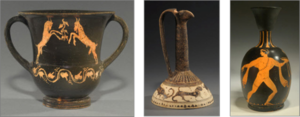 Yesterday’s repatriation ceremony after the seizure should be viewed as an example to collectors, dealers, and other art institutions. The US government treats these crimes seriously and will pursue the rightful return of plundered goods. Assistant District Attorney, and famed cultural heritage preservationist, Matthew Bogdanos, is a inspiring advocate for the rightful restitution of cultural property. During the ceremony, he spoke about the well-documented cultural plunder that occurred in Italy, and the impossibility of determining the number of objects that have been looted. Some have appeared on the art market, however many are still hidden in private and public collections. Congratulations to the US and Italian agents working on this case!
Yesterday’s repatriation ceremony after the seizure should be viewed as an example to collectors, dealers, and other art institutions. The US government treats these crimes seriously and will pursue the rightful return of plundered goods. Assistant District Attorney, and famed cultural heritage preservationist, Matthew Bogdanos, is a inspiring advocate for the rightful restitution of cultural property. During the ceremony, he spoke about the well-documented cultural plunder that occurred in Italy, and the impossibility of determining the number of objects that have been looted. Some have appeared on the art market, however many are still hidden in private and public collections. Congratulations to the US and Italian agents working on this case!
The repatriated objects will be displayed at the General Consulate of Italy in NY, and then displayed at museums located in Italy.
http://manhattanda.org/press-release/8th-century-bce-bronze-statues-among-collection-ancient-artifacts-being-repatriated-it
http://english.alarabiya.net/en/variety/2017/05/26/US-returns-stolen-archeological-artifacts-to-Italy-.html
http://www.kiro7.com/news/looted-statues-pottery-returned-to-italy-after-probe-in-nyc/526609581

 Last month, Assistant District Attorney Matthew Bogdanos petitioned the NY Supreme Court to turn over an Achaemenid limestone bas-relief that had been looted from Iran. Referred to as a “Persian Guard Relief,” the rare object was stolen from Persepolis in 1935. Our founder, Leila A. Amineddoleh, was instrumental in the filing of this case.
Last month, Assistant District Attorney Matthew Bogdanos petitioned the NY Supreme Court to turn over an Achaemenid limestone bas-relief that had been looted from Iran. Referred to as a “Persian Guard Relief,” the rare object was stolen from Persepolis in 1935. Our founder, Leila A. Amineddoleh, was instrumental in the filing of this case.



 Yesterday’s repatriation ceremony after the seizure should be viewed as an example to collectors, dealers, and other art institutions. The US government treats these crimes seriously and will pursue the rightful return of plundered goods. Assistant District Attorney, and famed cultural heritage preservationist, Matthew Bogdanos, is a inspiring advocate for the rightful restitution of cultural property. During the ceremony, he spoke about the well-documented cultural plunder that occurred in Italy, and the impossibility of determining the number of objects that have been looted. Some have appeared on the art market, however many are still hidden in private and public collections. Congratulations to the US and Italian agents working on this case!
Yesterday’s repatriation ceremony after the seizure should be viewed as an example to collectors, dealers, and other art institutions. The US government treats these crimes seriously and will pursue the rightful return of plundered goods. Assistant District Attorney, and famed cultural heritage preservationist, Matthew Bogdanos, is a inspiring advocate for the rightful restitution of cultural property. During the ceremony, he spoke about the well-documented cultural plunder that occurred in Italy, and the impossibility of determining the number of objects that have been looted. Some have appeared on the art market, however many are still hidden in private and public collections. Congratulations to the US and Italian agents working on this case!